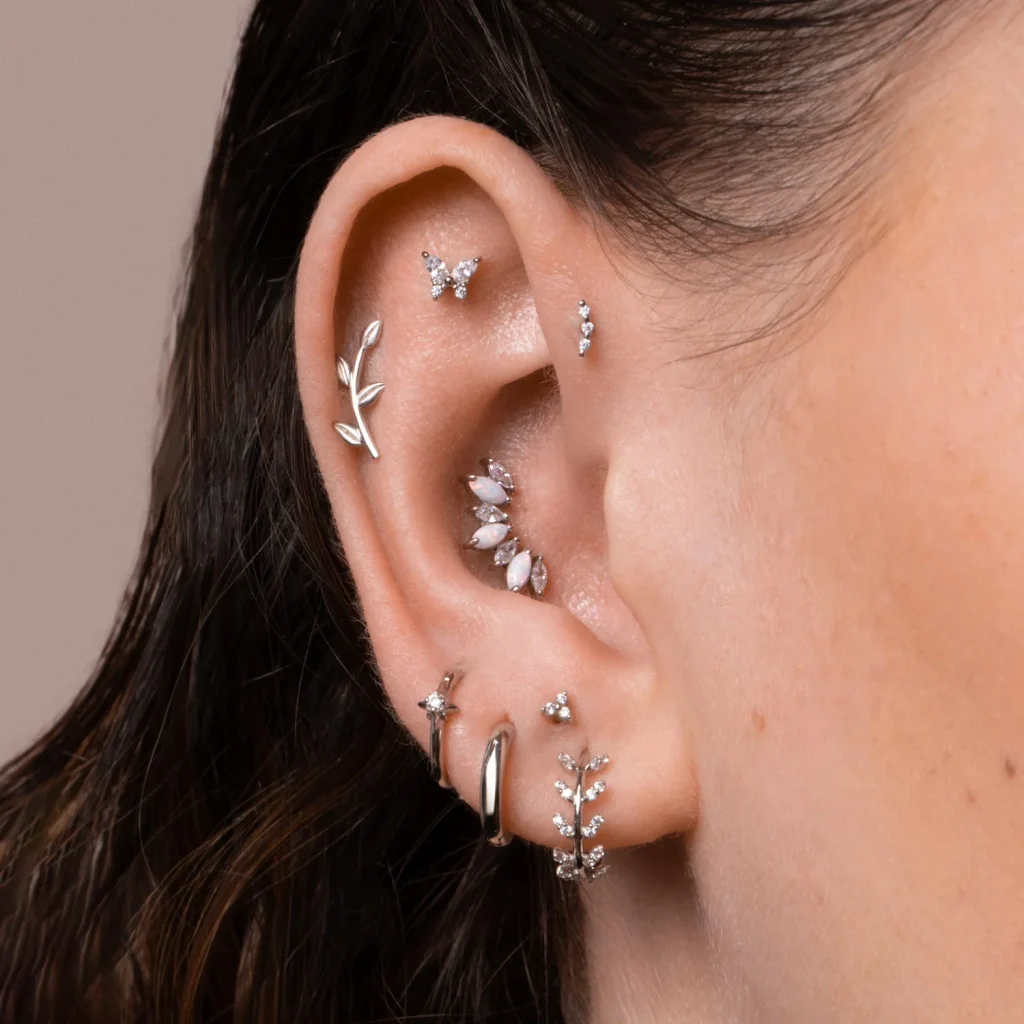Introduction
Conch piercings are more than just a bold fashion statement—they’re a celebration of individuality and a testament to the growing popularity of unique body modifications. Located in the inner cartilage of the ear, the conch piercing has been embraced for its aesthetic appeal and versatility. This article will guide you through everything you need to know about conch piercings, from the different types to how to care for them and the latest trends.
What Is a Conch Piercing?
A conch piercing is done through the cartilage of the ear’s inner shell, known as the conch. This area is named after the conch shell due to its similar shape. There are two main types of conch piercings:
- Inner Conch Piercing: Located in the central part of the conch, this piercing offers a more subtle look and can be adorned with small hoops or studs.
- Outer Conch Piercing: Positioned towards the outer edge of the conch, this piercing is often paired with other ear piercings and can be styled with larger hoops or elaborate jewelry.
Choosing the Right Jewelry
When selecting jewelry for a conch piercing, it’s crucial to choose high-quality materials to ensure both comfort and safety. Here are some popular options:
- Hoops: Both small and large hoops can be used, depending on personal preference. They offer a sleek, modern look.
- Studs: Simple and elegant, studs are a great choice for a minimalist style.
- Barbells: Straight or curved barbells can add a unique touch and are especially popular for outer conch piercings.
Materials: Opt for hypoallergenic metals like titanium, surgical steel, or gold to minimize the risk of irritation and infection.
Pain and Healing Process
The pain level for a conch piercing is often described as moderate. Since it’s done through cartilage rather than soft tissue, expect a sharp but brief sensation during the procedure. Aftercare is crucial for a smooth healing process, which generally takes between 6 to 12 months.
Healing Stages:
- Initial Weeks: Expect swelling, tenderness, and some bleeding. It’s normal for the area to be sore.
- 1 to 3 Months: The piercing may feel less sensitive, but be vigilant about cleaning and avoiding irritation.
- 6 to 12 Months: The piercing should be mostly healed by this stage, though complete healing can take up to a year.
Aftercare Tips
Proper aftercare is essential to avoid complications and promote healing. Follow these guidelines:
- Clean Regularly: Use a saline solution or a mild, alcohol-free cleanser. Avoid using hydrogen peroxide or alcohol, as these can be too harsh.
- Avoid Touching: Minimize contact with the piercing to reduce the risk of infection.
- Change Bedding and Pillowcases: Keep your sleeping environment clean to avoid introducing bacteria.
- Avoid Swimming: Refrain from swimming in pools, hot tubs, or natural bodies of water until the piercing is fully healed.
- Use a Soft Pillow: To avoid bumping or pressing on the piercing while sleeping, consider using a soft, non-abrasive pillow.
Potential Risks and Complications
Like all piercings, conch piercings come with risks, including:
- Infection: Redness, swelling, and discharge can be signs of infection. If these symptoms occur, consult a healthcare professional.
- Cartilage Bumps: Keloids or hypertrophic scars can form if the piercing is irritated. If a bump develops, seek advice from a professional piercer.
- Rejection: Although rare, the body may push out the jewelry, leading to piercing rejection. Choosing a reputable piercer and following aftercare instructions can minimize this risk.
Styling and Trends
Conch piercings offer a versatile canvas for creative expression. Current trends include:
- Layering Jewelry: Combining multiple piercings with various styles creates a chic, coordinated look.
- Minimalist Designs: Small, delicate jewelry pieces are trending, allowing the conch piercing to shine without overwhelming the ear.
- Mixed Metals: Combining different metal tones can add a modern, eclectic touch to your ear jewelry.
Celebrity Inspiration: Many celebrities have embraced the conch piercing, from fashion-forward stars to rock musicians. Look to your favorite icons for inspiration on how to style your conch piercing.
Conclusion
The conch piercing is a stylish and unique way to express your individuality. With the right care and attention, it can become a standout feature of your personal style. Whether you prefer a subtle look or an eye-catching statement, the conch piercing offers endless possibilities for customization and creativity.
FAQs
- Is a conch piercing painful?
- The pain level is moderate, with a sharp but brief sensation during the piercing.
- How long does it take for a conch piercing to heal?
- Healing can take between 6 to 12 months, with the initial healing phase being the most critical.
- What type of jewelry is best for a conch piercing?
- Hypoallergenic materials like titanium, surgical steel, or gold are ideal. Hoops, studs, and barbells are popular choices.
- Can I change my jewelry before the piercing is fully healed?
- It’s best to wait until the piercing is fully healed before changing jewelry to avoid complications.
- What should I do if my conch piercing gets infected?
- Consult a healthcare professional for treatment if you notice signs of infection such as redness, swelling, or unusual discharge.

